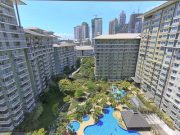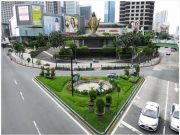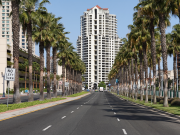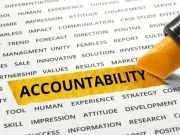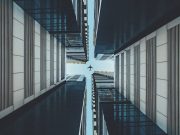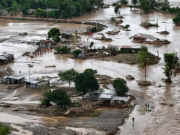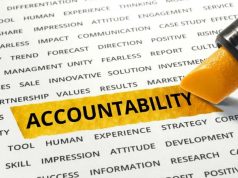The Urgent Need for Sustainable Housing in the Philippines
The Philippines is grappling with rapid city growth, a massive housing shortage of 6.5 million homes, expected to hit 22 million by 2040, and growing climate change risks. This situation demands that all new housing be built with strong environmental and sustainability measures. Although the country has solid green building laws, they are often not fully enforced due to high upfront costs, a lack of public awareness about long-term benefits, and uncoordinated government efforts. To succeed, sustainable housing must also address social and economic factors like affordability, community involvement, and the creation of green jobs; otherwise, it risks failing to serve those most in need and hindering overall urban development.
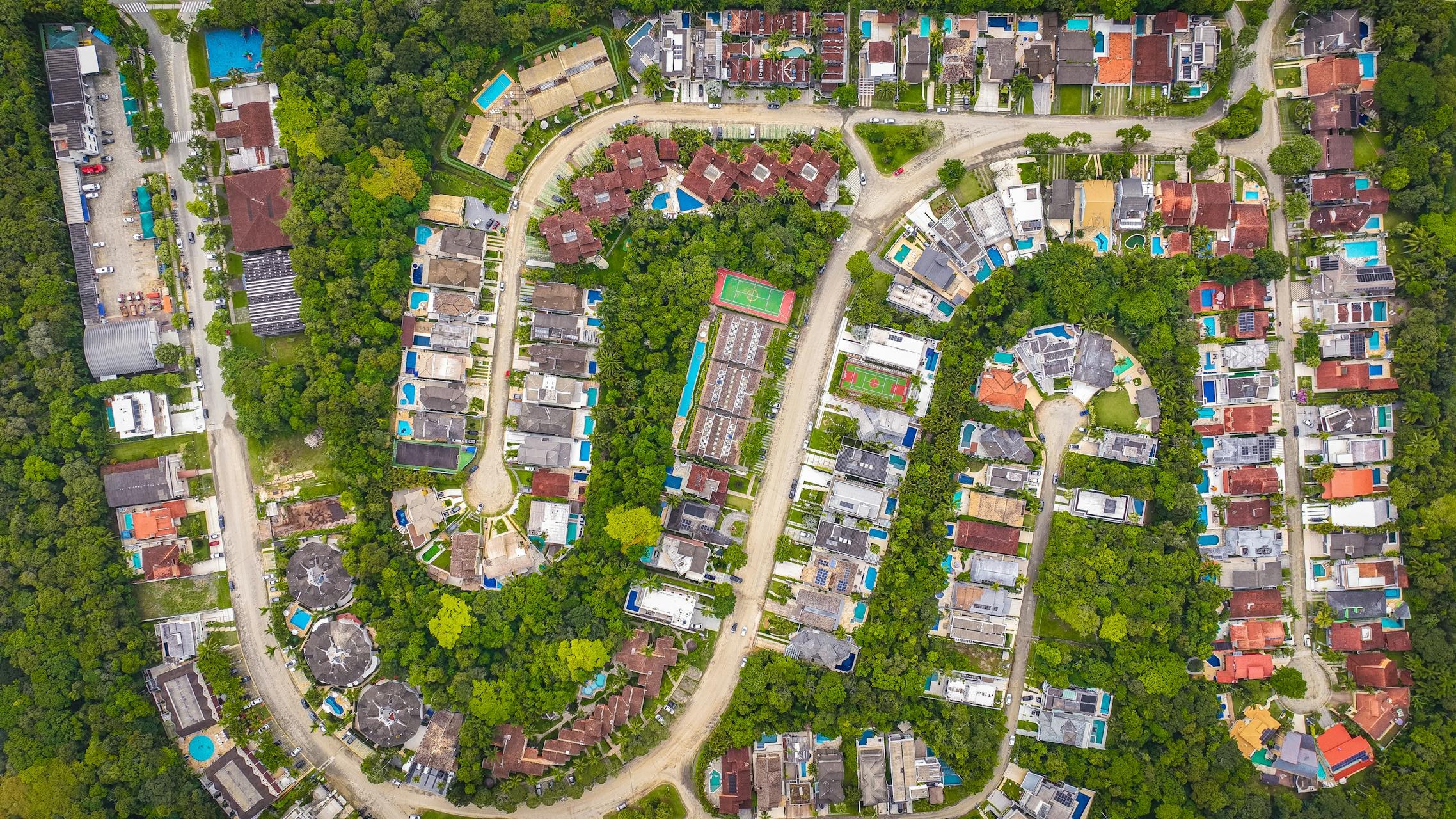
Photo by Sérgio Souza
Challenges in Implementing Green Building Regulations
While the Philippines has strong environmental laws, such as the Environmental Impact Statement (EIS) System, the Clean Water Act, and the Green Building Code, they’re often not fully enforced. This is due to several factors:
- High initial costs: Green technologies are often seen as too expensive upfront.
- Lack of awareness: Many people and developers don’t understand the long-term benefits of sustainable building.
- Fragmented responsibilities: There’s a lack of clear ownership and coordination among government agencies.
This gap between policy and practice needs immediate attention to make a real difference.
A Holistic Approach to Sustainable Housing
Creating sustainable housing in the Philippines isn’t just an environmental issue; it’s also about social and economic well-being. To succeed, we need solutions that:
- Address affordability: Ensure housing is accessible to everyone.
- Engage communities: Involve residents in the development process.
- Create green jobs: Promote employment opportunities in sustainable industries.
Without this comprehensive approach, efforts to make housing greener may not meet the needs of vulnerable communities or achieve widespread adoption, ultimately hindering the goal of fair and resilient urban development.
Housing and Urbanization in the Philippines: A Growing Challenge
The Philippines is rapidly urbanizing, with its urban population more than tripling since 1975 to over half the country’s residents by 2020. This growth is straining resources and creating a severe housing deficit, currently at 6.5 million units and projected to reach 22 million by 2040 if not addressed, especially impacting informal settler families. While the government’s Pambansang Pabahay para sa Pilipino (4PH) Program aims to build 1 million homes yearly, it faces significant challenges: homes are often too expensive for low-income families, and the types of housing offered, like high-rise buildings, don’t match what families need or prefer.
Sustainable Housing Solutions
Due to climate change, the Philippines faces more frequent and severe natural disasters. This is a huge threat, especially to underserved communities living in informal settlements made from poor materials. These homes can’t withstand typhoons, floods, mudslides, and rising sea levels. Because of this, including disaster risk reduction in housing design isn’t just a good idea—it’s necessary to protect lives and build stronger communities.
Why Sustainable Housing is Crucial for the Philippines
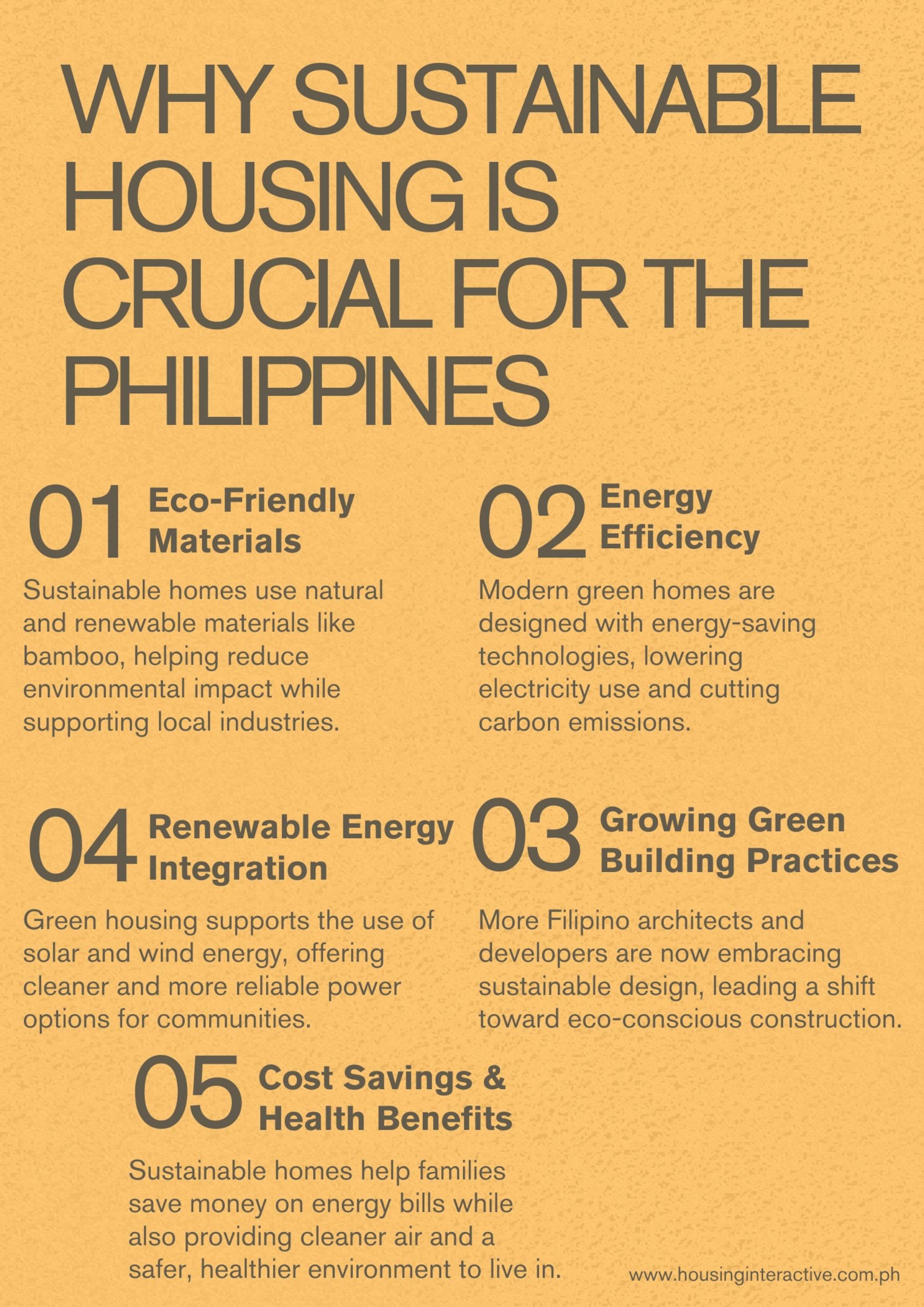
- Sustainable housing solutions in the Philippines utilize eco-friendly materials, such as bamboo, and incorporate energy-efficient technologies to reduce homes’ carbon footprint.
- Green building practices are becoming more prevalent in the country, with many architects and builders leading sustainable design and construction.
- Renewable energy sources, such as wind and solar power, are also rising, providing a more sustainable alternative to traditional energy sources.
- Sustainable housing solutions offer significant environmental benefits, deliver cost savings for homeowners, and create safer, healthier living environments.
The Need for Green Planning
With a huge housing shortage and rapid urbanization, the Philippines must embrace green planning for all new housing. Continuing with old building methods risks long-term environmental damage and increased vulnerability to climate change. We can protect natural resources and biodiversity by using eco-friendly designs and materials. This shift to sustainable housing also offers major economic benefits, including driving growth, supporting local businesses, and creating green jobs. The government’s ambitious housing goals must integrate sustainability principles into every development step to ensure new homes boost climate resilience and environmental protection, rather than worsening existing problems.
Regulations for Sustainable Housing in the Philippines
The Philippines is actively pursuing sustainable development in its housing sector, focusing on energy-efficient and green building practices. This is vital for reducing the country’s carbon footprint and mitigating climate change impacts, especially given its vulnerability to natural disasters. The government supports this shift with various regulations and standards, including the National Building Code (PD 1096), affordable housing standards (BP 220), and specific codes for electrical, fire, plumbing, labor, zoning, and accessibility ensuring builders and architects prioritize environmentally friendly methods and waste reduction, aligning with global sustainability goals.
1. Environmental Impact Statement (EIS) System (PD 1586)
A crucial environmental protection system requires significant projects to obtain an Environmental Compliance Certificate (ECC) before starting. This certificate confirms the project won’t cause major environmental harm and that the developer will follow a plan to manage impacts on geology, biology, and society. Large housing developments or those in sensitive areas specifically need an ECC. However, a key weakness is the lack of clear environmental impact thresholds for all housing projects, which means smaller developments, despite their potential collective harm, might be inconsistently regulated or overlooked.
2. Clean Water Act (RA 9275)
Despite the Clean Water Act requiring permits for wastewater discharge and agencies managing sewage, water pollution remains a major issue in the Philippines. Only about 10% of wastewater is treated, leading to 58% groundwater contamination. Most households rely on poorly maintained septic tanks that often release untreated waste into drainage systems, highlighting a significant gap between law and practice, and posing serious health and environmental risks to homes.
3. Ecological Solid Waste Management Act (RA 9003)
This law promotes proper waste management to protect public health and the environment. Local governments are in charge of enforcing it. Key requirements include:
- Mandatory waste segregation at the source (e.g., in homes).
- Designated areas and containers for waste segregation in multi-residential buildings.
- Materials Recovery Facilities (MRFs) in every community for sorting, composting, and recycling.
- Waste diversion goals: Local governments must reduce waste sent to disposal facilities by at least 25% through reuse, recycling, and composting.
However, results fall short: The national recycling rate is only 5%, and many local governments report lower waste diversion rates. Only 32% of communities have MRFs. This means the law isn’t fully implemented, highlighting the need for stronger enforcement, public awareness, and investment in better waste management infrastructure.
4. Climate Change Act of 2009 (RA 9729)
The Climate Change Act of 2009 is a vital Philippine law that aims to integrate climate change into all government policies, creating the Climate Change Commission and requiring local governments to develop their climate action plans. Despite this strong legal foundation, the Philippines remains highly vulnerable to worsening natural disasters like droughts, fires, floods, and storms, which heavily impact homes. This suggests that while the policy framework is robust, its effective, widespread application for climate-resilient housing and urban planning still faces significant challenges, possibly due to issues with local capacity, funding, or the sheer scale of the threats.
5. Energy Efficiency and Conservation Act (RA 11285)
The Energy Efficiency and Conservation Act (RA 11285) requires large new buildings (with at least 112.5 kVA electrical load or 10,000 square meters of floor area) and major renovations in the Philippines to meet minimum energy-efficient design standards. However, despite this law and the economic incentive of high electricity costs, widespread adoption of energy efficiency remains a challenge. This is because the Philippines still heavily relies on fossil fuels for most of its electricity, and the energy efficiency market is still underdeveloped, limiting the law’s full impact, especially on smaller developments not covered by mandatory requirements.
6. National Building Code (PD 1096) and Green Building Guidelines (EO 1000)
The National Building Code is the basic regulation for construction. Complementing this is the Philippine Green Building Code (PGBC), which promotes sustainable construction to reduce environmental impact. The PGBC encourages:
- Energy-efficient designs (like natural ventilation, daylighting, and efficient lighting/AC).
- Water conservation (rainwater harvesting, water-saving fixtures).
- Sustainable materials (local, recycled, low-VOC).
- Proper waste segregation during construction and throughout the building’s life.
- Good indoor environmental quality.
- Site sustainability (reducing stormwater runoff, improving biodiversity).
- Renewable energy use.
- Building performance monitoring.
While comprehensive, the Green Building Code often serves as a guideline rather than a strict requirement for all housing projects, especially smaller ones. Its effectiveness mostly depends on voluntary certifications like BERDE, LEED, and GREEEN. This means widespread adoption of advanced green building practices is still largely driven by choice or local government initiatives, rather than universal regulation for features beyond basic safety.
Who Manages Sustainable Housing in the Philippines?
Achieving sustainable housing in the Philippines requires a strong government framework that actively promotes green practices and reduces environmental impact. While policies and incentives exist for homeowners and builders, it’s crucial to establish a regulatory system that enforces sustainable building codes and standards. This framework can be further strengthened by adopting international best practices. Several government agencies are instrumental in regulating and promoting these environmental and sustainability practices in Philippine housing developments.
- The Department of Environment and Natural Resources (DENR) and its Environmental Management Bureau (EMB) enforce environmental laws like the EIS System, Clean Water Act, and Clean Air Act. They issue key environmental permits such as Environmental Compliance Certificates (ECCs) and wastewater discharge permits.
- The Department of Human Settlements and Urban Development (DHSUD), formed in 2019, is the main housing authority. It manages overall housing development, including the 4PH program to build more homes. DHSUD also oversees local shelter planning and integrates public health goals into land use plans.
While centralizing housing and urban development under DHSUD could streamline sustainable housing policies, numerous other government agencies like the Department of Energy (DOE), Department of Public Works and Highways (DPWH), Department of Health (DOH), and various Local Government Units (LGUs are also involved in environmental regulation. This fragmented involvement, especially among water agencies, can lead to coordination problems and bureaucratic roadblocks, hindering sustainable development. Therefore, effective teamwork and clear roles among these agencies are crucial for a unified approach to sustainable housing.
How New Housing Developments Impact the Environment
Rapid urbanization and new housing in the Philippines significantly impact the environment. While sustainable housing offers crucial benefits like reduced emissions, resource conservation, and biodiversity protection, its adoption faces hurdles such as high upfront costs and limited awareness. To build more sustainable and resilient homes, it’s vital to prioritize environmental impact by reducing waste, promoting recycling, and conserving natural resources throughout every stage of design and construction.
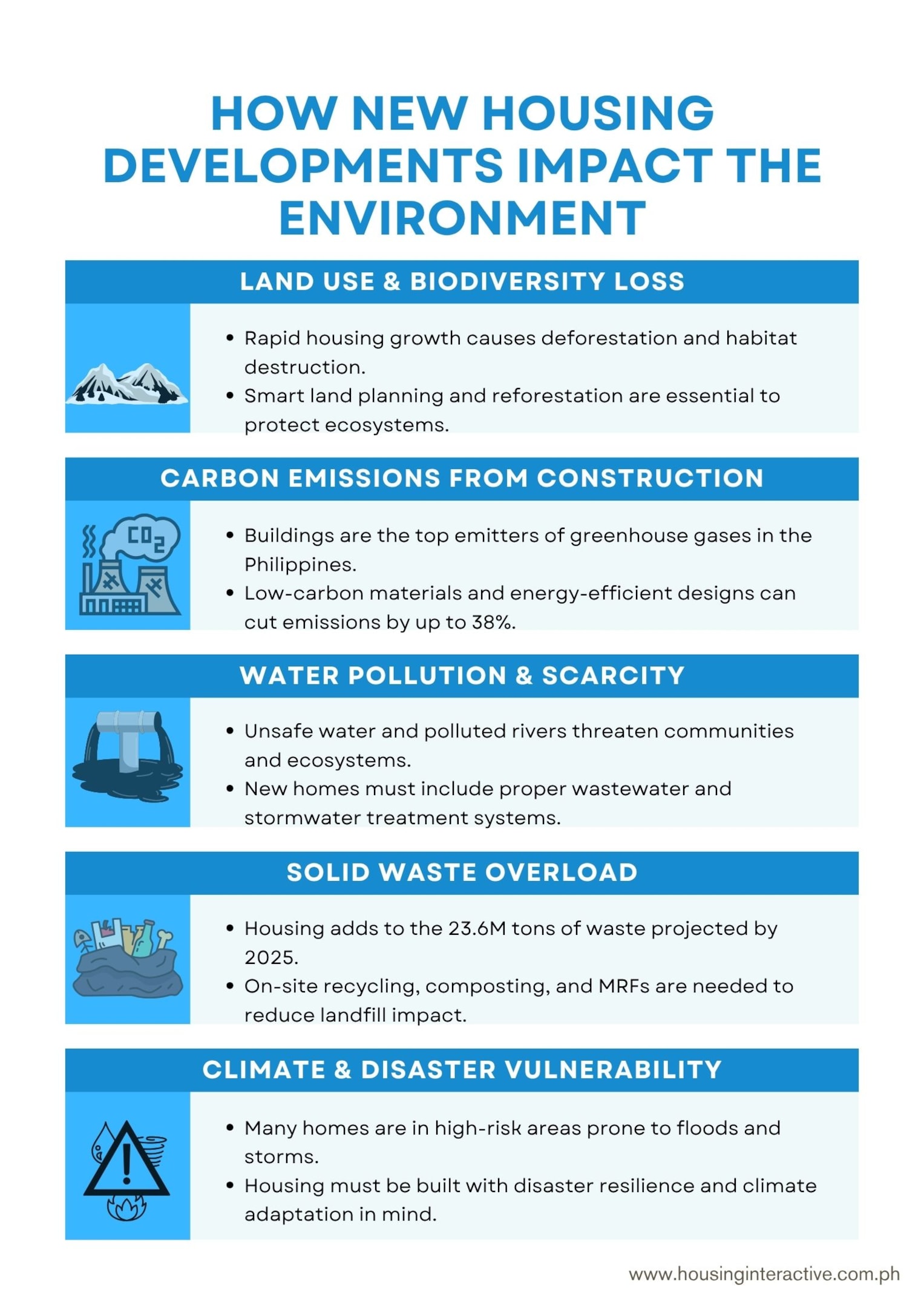
1. Land Use Change, Deforestation, and Biodiversity Loss
Rapid urban and housing expansion in the Philippines is directly causing deforestation and biodiversity loss. Between 2001 and 2022, the country lost 1.42 million hectares of tree cover, releasing 848 metric tons of CO2 and destroying critical habitats. This also worsens soil erosion, flooding, and droughts. New housing, even for social needs, drives environmental damage, so land-use planning must avoid ecological areas and include strong reforestation or biodiversity protection from the start, especially as low-income housing often ends up in vulnerable, sensitive zones.
2. Carbon Footprint of Construction and Operations
The construction sector is a major contributor to greenhouse gas emissions, using 40% of global materials. In 2021, the Philippine building sector contributed 13.5 million tonnes of GHG, making it the country’s largest emitter. Green building practices must meet their 75% emission reduction target by 2030. Early design choices, particularly for energy efficiency and sustainable materials, are critical, as they can cut material and energy input by up to 38% compared to traditional methods, requiring a shift to low-carbon construction.
3. Water Resource Strain and Pollution
The Philippines faces severe challenges with water access and pollution. Many households rely on unsafe water, and 2.4% use unsafe sources like surface water and unprotected wells/springs. A major issue is that 43% of rivers are polluted due to untreated domestic sewage and industrial and agricultural wastes. Most rely on inadequate septic tanks that discharge untreated waste, worsening pollution, and increasing flooding. All new developments must include mandatory on-site wastewater treatment and stormwater management systems to prevent further environmental and public health deterioration.
4. Solid Waste Generation and Management Challenges
The Philippines is facing a growing solid waste crisis due to urbanization, with waste generation projected to hit 23.61 million tons by 2025. Homes generate 57% of city waste, yet the national recycling rate is only 28%. Many areas lack sufficient Materials Recovery Facilities (MRFs), and construction adds massive waste to landfills. New housing developments significantly contribute to this crisis, highlighting the need for comprehensive on-site material recovery, composting, and community engagement to promote a more circular economy.
5. Vulnerability to Climate Change and Natural Disasters
The Philippines is highly vulnerable to climate change and natural disasters, experiencing more frequent and severe droughts, fires, floods, and storms that severely impact homes, especially informal settlements. This ongoing threat means climate resilience is fundamental for all housing development requirements. Site selection, design, and materials for new housing must explicitly integrate strong disaster risk reduction and climate adaptation measures to protect lives, property and ensure long-term community stability, moving beyond mere compliance to proactive resilience building.
Building Sustainable Homes in the Philippines: Key Strategies
Sustainable housing in the Philippines prioritizes designs that are tropical climate-friendly and disaster-resilient. This means architects and builders focus on energy efficiency, natural ventilation, and using local materials. Key strategies include integrating green spaces, greatly reducing waste, and using innovative technologies like insulated panels and solar roofs. Critically, managing energy and resources effectively means cutting consumption, boosting renewable energy, using energy-efficient appliances, implementing rainwater harvesting, and promoting robust waste management and recycling. The Philippine government supports these efforts with policies and incentives for homeowners and builders.

1. Green Building Design and Construction
In the Philippines, Green Building focuses on energy efficiency through passive design (natural ventilation, daylighting) and efficient systems (LED lighting, energy-efficient AC). It also promotes renewable energy like solar, with a national goal of 50% renewables by 2040, supported by tax breaks and net metering. However, rooftop solar adoption remains low due to high upfront costs (around P100,000 or $1,700), limited affordable financing, lack of public awareness, and lengthy permits. Overcoming these barriers requires targeted financial aid, simpler procedures, and strong public education.
2. Water Conservation and Management
Water conservation and management are critical in the Philippines, where many areas have limited access to clean water. The Green Building Code promotes rainwater harvesting, water-saving fixtures, and greywater recycling for non-drinking uses. Despite low national wastewater treatment rates (around 10%), there’s a need for better, cheaper solutions like decentralized systems and Constructed Wetlands, with stricter standards for larger developments. Given increasing water scarcity and inadequate municipal infrastructure, on-site water conservation and treatment are crucial, requiring regulations to mandate and incentivize these systems in new housing.
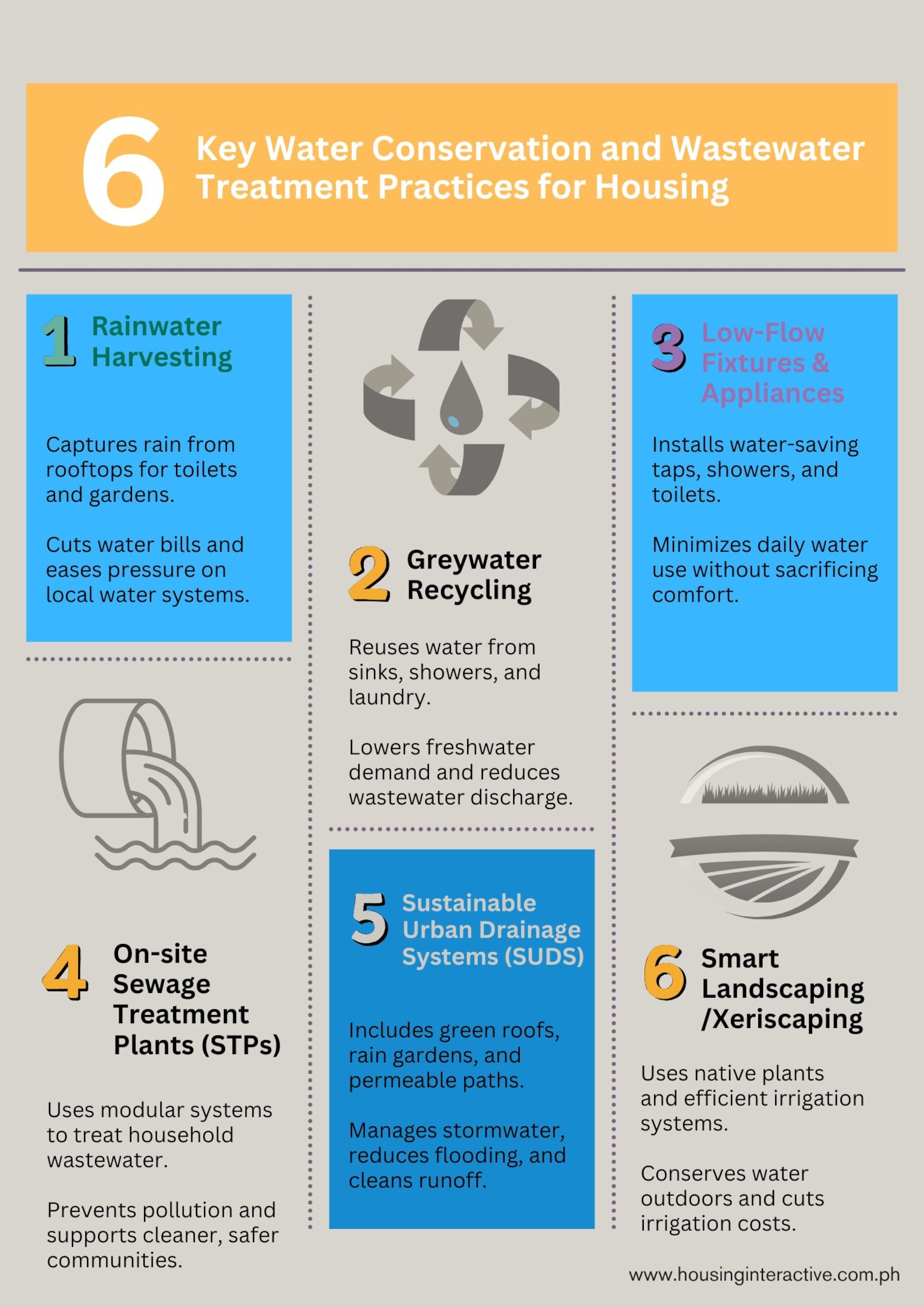
3. Sustainable Materials and Waste Reduction
The Philippine Green Building Code champions a circular economy by promoting sustainable, locally sourced, and recycled materials (bamboo, low-carbon cement, and plastic-waste bricks) and low-Volatile Organic Compound (VOC) products. This approach reduces resource depletion and carbon footprint. The Code also mandates proper waste segregation during construction and a building’s lifecycle. With massive construction and residential waste, new housing must adopt comprehensive on-site material recovery, composting, and potentially waste-to-energy solutions. Policies are needed to incentivize recycled content, local sustainable materials, modular construction, and robust national systems for construction and demolition waste recycling.
4. Biodiversity-Friendly Site Planning and Green Infrastructure
Sustainable housing increasingly emphasizes protecting biodiversity and natural resources through careful site selection. The Philippine Green Building Code promotes sustainable site development to minimize negative environmental impacts and enhance green spaces. Urban biodiversity provides essential services like flood control. Integrating “green infrastructure” (e.g., permeable pavements, green roofs, rain gardens) improves urban water management, reduces flood risks, enhances aesthetics, and creates new habitats. Given urbanization’s impact on biodiversity, new housing developments should make biodiversity-friendly site planning and green infrastructure core design elements, supported by stronger zoning rules that protect habitats, mandate green space ratios, and promote ecological corridors.
Overview of Green Building Certifications in the Philippines
| Certification Name | Key Focus Areas | Status (Voluntary/Mandatory, Recognition) | Relevance to Housing |
| BERDE (Building for Ecologically Responsive Design Excellence) | Energy efficiency, water conservation, waste management, materials, indoor environmental quality, land use & ecology, transportation, emissions, heritage, innovation. | Voluntary; Recognized as the National Voluntary Green Building Rating System by DOE. | Covers new construction, renovations, and operations for vertical and clustered residential buildings. |
| LEED (Leadership in Energy and Environmental Design) | Energy efficiency, water savings, sustainable site development, material selection, indoor environmental quality, and design innovation. | Voluntary; Recognized by PEZA for Green, Healthy, Smart, and Sustainable Ecozone Award. | Covers commercial buildings, residential complexes, and educational institutions. Specific “LEED for Homes” for single-family and multi-family. |
| GREEEN (Geared for Resiliency and Energy Efficiency for the Environment) | Code-based, environment-responsive criteria for new construction and major renovations, aiding in green building goals. | Purely Voluntary. | Evaluates buildings, applicable to residential projects undergoing new construction or major renovations. |
| EDGE (Excellence in Design for Greater Efficiencies) | Minimum 20% savings in water and embodied energy, 40% energy savings on-site, 100% energy savings through renewables or carbon offset (for Zero Carbon). | Voluntary. | Covers homes, education, hospitality, hospitals, light industries, offices, retail, and warehouses. |
Green Housing in the Philippines: Challenges and Opportunities
Adopting green housing practices in the Philippines faces persistent hurdles, but there are also many opportunities.
Barriers to Green Housing
Several interconnected issues prevent widespread green housing adoption:
- Cost Concerns: Many believe green buildings are too expensive upfront due to higher costs for technology and materials. For example, rooftop solar is pricier in the Philippines than in neighboring countries because of import duties, logistics, and a less developed supply chain. People with limited funds are often unsure if the long-term savings justify the initial investment.
- Awareness Gap: Many people don’t fully understand the long-term benefits of green buildings, like savings on energy and maintenance. This lack of knowledge also applies to rooftop solar and how to find reliable installers. Misinformation about solar system reliability and maintenance also makes people hesitant.
- Regulatory Roadblocks: Current rules sometimes don’t fully support green building, making it hard for developers. Compliance with the Green Building Code is often optional, and existing environmental laws aren’t consistently enforced. Long permit processes for renewable energy systems also slow down adoption.
- Technology Access: Smaller construction companies often can’t afford the latest sustainable technologies or lack the expertise to use them. There’s also a general shortage of skilled workers and experts in green construction, making it hard to scale up these practices. Limited access to technical support and financing, especially for homes and small businesses, is another significant barrier.
These consistent problems point to a systemic challenge in making green housing widespread. Policies need to be comprehensive, addressing financial accessibility (e.g., green mortgages, targeted subsidies), implementing widespread public education campaigns, and establishing streamlined, mandatory regulations with strong enforcement. A fragmented approach won’t lead to significant, transformative results.
Incentives and Policy Support
Despite the barriers, the Philippines has a growing number of incentives and policies to promote sustainable housing:
- The government backs sustainable housing through initiatives like the Green Building Code and offers incentives to developers.
- Financial institutions are increasingly providing “green financing” with lower interest rates and better loan terms for sustainable homes.
- Public sector initiatives, like the Bureau of the Treasury and SEC frameworks for green bonds, set standards for public investment in sustainable projects.
- The Bangko Sentral ng Pilipinas (BSP) encourages green financing among banks with incentives like additional loan limits and a 0% reserve requirement for sustainable bonds.
- Local governments like Makati City offer reduced property taxes and increased building density for green-certified buildings.
- The Renewable Energy Act of 2008 provides significant incentives for renewable energy developers, including tax holidays and duty-free imports.
- The net metering program allows homeowners with solar panels to sell excess energy back to the grid, reducing electricity costs.
While these incentives are promising, their full impact is limited by the barriers mentioned earlier. To be truly effective, incentives need continuous evaluation and adjustment to specifically target the biggest hurdles. Making green financing truly accessible to low-income households and simplifying application processes are crucial steps to ensure these policies lead to tangible adoption across all segments of the population.
Success Stories and Best Practices
Despite the challenges, many successful projects show that green housing solutions are technically possible and offer real benefits in the Philippines. These examples provide valuable blueprints for scaling up sustainable development.
- Green Communities: Large developments like Nuvali in Laguna and Alviera in Pampanga prioritize sustainable building, energy efficiency, and preserving natural landscapes. Liora Homes Naic is the Philippines’ first BERDE Certified Residential District, with solar panels on every home (reducing electricity bills by 30%) and rainwater harvesting systems (cutting water bills by 35%).
- Material Innovation: New materials are emerging:
- Base Bahay Foundation’s Cement Bamboo Frame Technology uses fast-growing, carbon-capturing bamboo for earthquake-resistant buildings.
- Holcim’s ECOplanet low-carbon cement reduces emissions by 30% using recycled construction waste.
- Green Antz’s EcoBrick and EcoCaste products use plastic waste in building materials, reducing the carbon footprint.
- Sustainably sourced lumber also has a smaller carbon footprint than concrete.
- Passive Design: BluHomes by Aztala Corporation uses native trees for natural shade, reflective exterior walls, roof insulation, and solar panels for LED lighting, reducing the need for artificial cooling and lighting.
- Community-Led Initiatives: The Donnaville Homeowners Association project successfully involved families in planning, leading to affordable and desirable designs that increased acceptance and reduced costs. The Philippine Action for Community-Led Shelter Initiatives, Inc. (PACSII) supports these efforts, empowering urban poor communities to manage their development.
- Waste Management: The Modena Mactan subdivision generates revenue from recycled waste through incentive schemes. Cebu City uses the Takakura composting method and strictly enforces “No Segregation No Collection” policies, with Barangay Environmental Officers educating residents on waste management.
- Stormwater Management: Integrating Sustainable Urban Drainage Systems (SUDS) like permeable pavements, green roofs, and rain gardens can significantly improve urban water management, reduce flood risks, and enhance urban aesthetics.
These successful examples prove that green housing solutions work and offer tangible environmental, social, and economic benefits in the Philippines. The key opportunity now is to scale these proven models through effective knowledge sharing, targeted replication programs, and policies that actively promote their widespread adoption, rather than constantly reinventing solutions. By leveraging these successes, the Philippines can speed up its transition to a more sustainable and resilient built environment.
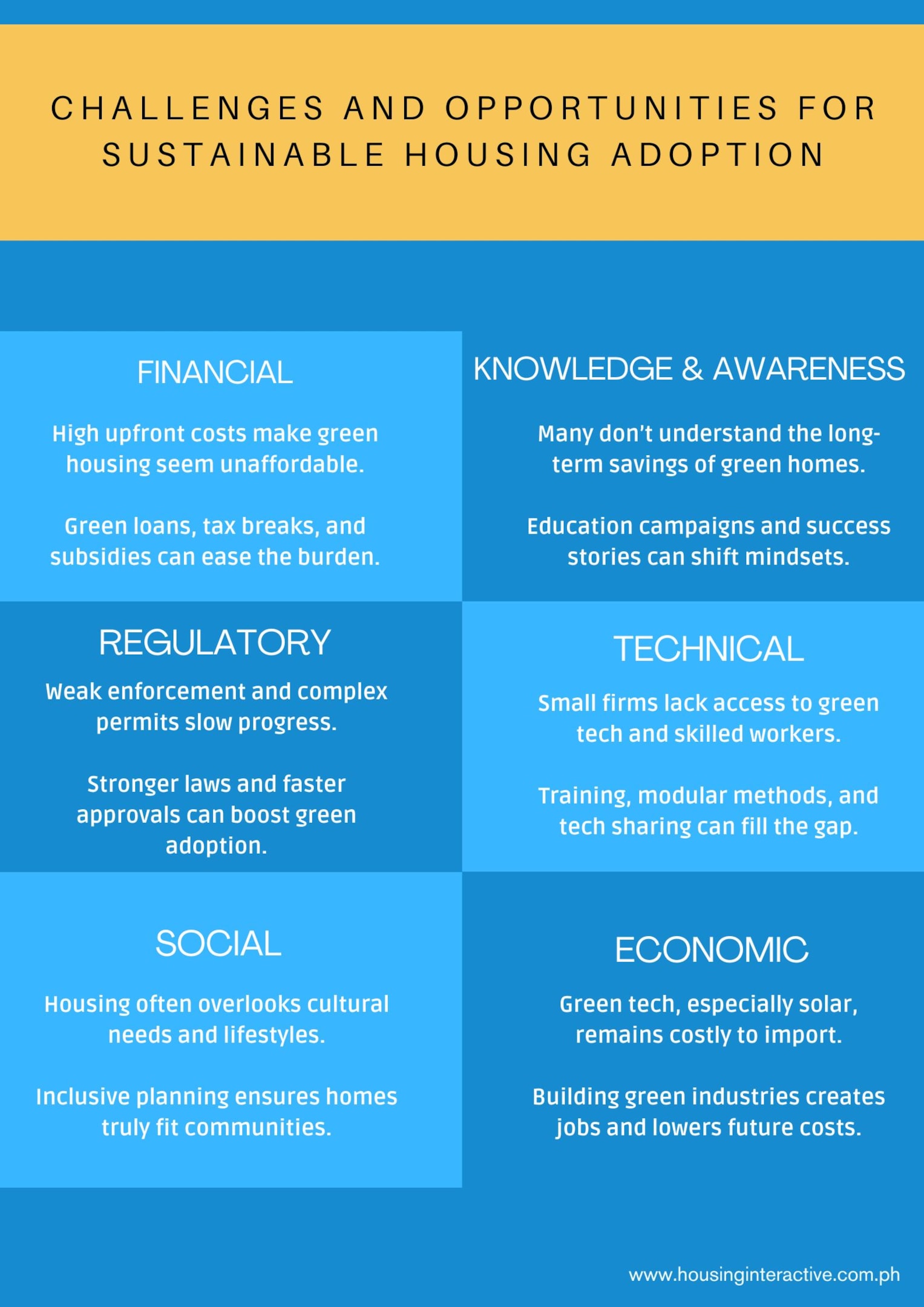
A New Path for Philippine Housing
The Philippines faces a critical need for sustainable housing due to rapid urbanization, a severe housing shortage, and high climate vulnerability. True sustainable housing must address environmental, social, and economic factors simultaneously for national development and climate resilience. While policies and pilot projects exist, the main hurdle is a systemic failure to connect policy, funding, and large-scale implementation. Future efforts must build a supportive system to ensure sustainable housing is environmentally sound, economically viable, and socially inclusive.
Strategic Recommendations
To accelerate the shift to sustainable housing, the Philippines should focus on these key strategies:
1. Strengthen and Enforce Regulations:
Implement mandatory environmental reviews for all housing projects, regardless of size. Require on-site wastewater treatment and stormwater management in all new developments, especially in water-stressed areas. Strictly enforce waste segregation laws and the establishment of Materials Recovery Facilities (MRFs). Finally, make climate-resilient building standards mandatory in the National Building Code, considering long-term climate projections and regional disaster risks.
2. Improve Financial Access and Incentives:
Expand green financing options like green mortgages and low-interest loans, making them accessible for affordable housing. Offer subsidies or tax breaks for rooftop solar and other renewables, simplifying their permitting. Incentivize local, sustainable, and recycled building materials through tax breaks or grants to boost local green industries.
3. Invest in Education and Training:
Launch comprehensive public education campaigns to highlight the long-term benefits of green housing and address misinformation. Develop and expand training programs for green building skills across the construction sector. Promote knowledge sharing and replication of successful green housing projects among local governments and private developers.
4. Prioritize Integrated and Participatory Planning:
Make climate change adaptation and disaster risk reduction central to all housing and land-use planning, avoiding sensitive or high-risk areas. Ensure genuine community engagement in all housing projects, especially for low-income families, to guarantee culturally appropriate and affordable solutions. Foster stronger inter-agency coordination among government bodies to create a unified policy environment.
5. Promote a Circular Economy:
Develop a national framework and infrastructure for recycling construction and demolition waste, with incentives for developers to divert waste from landfills and use recycled content. Actively support the growth of local supply chains for sustainable building materials like engineered bamboo and recycled plastic products, thereby creating green jobs.
Building sustainable housing in the Philippines is a complex but achievable goal. It needs a joint effort from many different groups, going beyond old ways of doing things. By turning today’s challenges into opportunities, the Philippines can create a more resilient, fair, and environmentally friendly future for everyone.
References:
[1] pntr.gov.ph green building code of the philippines parking slots
[2] r12.emb.gov.ph Solid Waste Management – EMB XII
[3] m.youtube.com First ever LEED Certified Residential Community in the Philippines. #santarosacity #thepropertygeek – YouTube
[4] fidic.org berde – FIDIC
[5] jur.ph Ecological Solid Waste Management Act – Jur.ph
[6] scribd.com Green building code | PDF | Green Building | Efficient Energy Use
[7] r12.emb.gov.ph RA 9275 – The Philippine Clean Water Act – EMB XII
[8] cdohomebuilder.com Construction Regulatory Standards in the Philippines
[9] resourcehub.bakermckenzie.com Planning and Environmental Issues | Philippines | Global Corporate …
[10] scribd.com PD 1586 – Philippine Environmental Impact Statement System …
[11] richestph.com Empowering Communities: Water Management Practices That Work in the Philippines
[12] legacy.doe.gov.ph National Renewable Energy Program | Department of Energy Philippines – DOE
[13] oecd.org Clean Energy Finance and Investment Roadmap of the Philippines | OECD
[14] philgbc.net Certification – Philippine Green Building Council
[15] acash.org.pk Sustainable Housing in Navotas, the Philippines-Field Study
[16] billionbricks.org How LEED Certification is Transforming Real Estate in the …
[17] dhsud.gov.ph DHSUD | Department of Human Settlements and Urban Development
[18] biogreenstp.com BioGreen – Sewage Treatment Plant, Wastewater Treatment, Philippines Advance STP WWTP
[19] ovcre.uplb.edu.ph The effect of urban sprawl on forest carbon stocks in La Mesa …
[20] aseaniwrm.water.gov.my Overview of IWRM in Philippines – ASEAN Integrated Water …
[21] depdev.gov.ph Policy Note on the Philippine Water Sector National Economic and …
[22] dpwh.gov.ph 1 6 MAR2018 – DPWH
[23] richestph.com The Future of Green Buildings in the Philippines – RichestPH
[24] engineeringforchange.org A LANDSCAPE ANALYSIS OF SUSTAINABLE, GREEN, AND …
[25] dhsud.gov.ph Environmental, Land Use and Urban Planning and Development – Department of Human Settlements and Urban Development – DHSUD
[26] dhsud.gov.ph Revised Implementing Rules and Regulations for PD 957 – DHSUD
[27] pmc.ncbi.nlm.nih.gov Wastewater Management in the Philippines: A Call for Localized Solutions and Policy Integration – PMC
[28] adb.org Green Infrastructure Investment Opportunities: Philippines 2020 Report – Asian Development Bank
[29] ilo.org Green Jobs in Asia – International Labour Organization
[30] pacsii.org About – PACSII
[31] mangrovealliance.org Green-Grey Infrastructure in the Philippines – The Mangrove Alliance
[32] cbdi.com.ph CBDI Advances Sustainable Residential Practices in the Philippines
[33] acash.org.pk Ensuring Inclusivity, Resilience, and Affordability of Housing for Low-Income and Informal Settler Families in the Philippines
[34] dbm.gov.ph Green, Green, Green pushes city governments to build better open spaces – DBM
[35] richestph.com Solving Housing Shortages: Affordable Solutions in PH – RichestPH
[36] susdrain.org Sustainable drainage – Susdrain
[37] emission-index.com Greenhouse Gas Emissions In The Philippines
[38] getuhoo.com Berde Certification: What it is and How it Benefits Your Building | uHoo
[39] resourcehub.bakermckenzie.com CO2 and Energy Targets | Philippines | Global Sustainable Buildings Guide
[40] resourcehub.bakermckenzie.com Green Certification | Philippines | Global Sustainable Buildings Guide | Baker McKenzie Resource Hub
[41] unhabitat.org After the storm: Culturally sensitive housing transforms lives in the Philippines – UN-Habitat
[42] habitat.org Ensuring inclusivity, resilience, and affordability of housing for low-income and informal settler families in the Philippines – Habitat for Humanity
[43] researchgate.net (PDF) USING GHSL TO ANALYZE URBANIZATION AND LAND-USE EFFICIENCY IN THE PHILIPPINES FROM 1975–2020: TRENDS AND IMPLICATIONS FOR SUSTAINABLE DEVELOPMENT – ResearchGate
[44] psa.gov.ph Urban Population of the Philippines (2020 Census of Population and Housing)
[45] ice.org.uk How Makati City In The Philippines Uses Incentives To Go Green …
[46] tribune.net.ph SHFC: Transforming housing in the Philippines – Daily Tribune
[47] business.inquirer.net Building the Filipino dream through purposeful developments
[48] richestph.com Sustainable Living: Eco-Friendly House and Lot Options in the …
[49] docs.berdeonline.org BERDE – Buildings – Version 5.0.0 – User Guide
[50] researchgate.net Green Building Construction Implementation Barriers in the …
[51] richestph.com The Rise of Sustainable Housing in the Philippines: Trends in Home …
[52] preventionweb.net The promises and challenges of the Philippines’ new climate …
[53] resourcehub.bakermckenzie.com Financing | Philippines | Global Sustainable Buildings Guide | Baker …
[54] researchgate.net (PDF) Community architecture: The use of participatory design in the …
[55] billionbricks.org Circular Economy and Remote Work in the Philippines …
[56] denr.gov.ph Intensified Environmental Protection: Solid Waste Management …
[57] slideshare.net The-EIS-System-in-Philippines.ppt – SlideShare
[58] climate.gov.ph Keeping up with deforestation – Climate Change Commission
[59] climate.emb.gov.ph Climate Change Act of 2009(RA 9729) | Climate Change Division
[60] lse.ac.uk PHILLIPINES – LSE
[61] wipo.int Wastewater Management in the Philippines – WIPO
[62] nativtechniks.com Solar Energy Policies in the Philippines: Investor’s Guide
[63] enptinio.com 15 Statistics about Solid Waste Management in the Philippines that …
[64] legacy.doe.gov.ph RE Developers | Department of Energy Philippines
[65] web.senate.gov.ph Philippine Solid Wastes – Senate of the Philippines
[66] pdp.depdev.gov.ph 12Building Safe, Resilient, and Sustainable Communities
[67] pab.emb.gov.ph DAO 2016-08 WQG and GES – EMB-Pollution Adjudication Board
[68] ilo.org Green jobs mapping study in the Philippines – International Labour Organization
[69] elibrary.judiciary.gov.ph MEMORANDUM CIRCULAR NO. 2017-05
[70] genieai.co Environmental Impact Assessment Report For Housing Development – Philippines | Genie AI
[71] adb.org Environmental Assessment and Review Framework Philippines: Water District Development Sector Project
[72] web.senate.gov.ph the state of water – Senate of the Philippines
[73] climate.gov.ph From Emissions to Efficiency: Embrace Green Building Practices in the Philippines – Climate Change Commission
[74] bmb.gov.ph Mainstreaming Biodiversity in the Infrastructure Sector
[75] mdpi.com Assessing the Effectiveness of Sustainable Drainage Systems (SuDS): Interventions, Impacts and Challenges – MDPI
[76] dpwh.gov.ph Philippine Green Building Code – DPWH
[77] ionexchangeglobal.com Water Recycling System for Sustainable Operations – Ion Exchange
[78] billionbricks.org Pinoy Homeowner’s Guide to Water Recycling – BillionBricks | Net-Zero Homes
[79] dergipark.org.tr Current construction and demolition waste management strategies for Philippine construction sector – A systematic literature review – DergiPark
[80] development.asia Optimizing Municipal Waste Collection in the Philippines through a Smart App
[81] billionbricks.org The Adoption of Sustainable Architecture in the Philippines – BillionBricks | Net-Zero Homes
[82] richestph.com Water conservation in the Philippines – RichestPH
[83] constructive-voices.com Philippines Top Green Buildings – Constructive Voices
[84] eia.emb.gov.ph Revised-Guidelines-for-Coverage-Screening-and-Standardized …
[85] mlit.go.jp Water Quality Guidelines and Effluent Standards and Its Implementation in the Philippines
[86] gbig.org Philippines: Green Building Information Gateway
[87] researchgate.net (PDF) Integrating Sustainable Urban Drainage Systems (SUDS) for …
[88] ejournals.ph Development of a Better Solid Waste Management Program for …
[89] habitat.org Green housing solutions in the Philippines – Habitat for Humanity
[90] newsinfo.inquirer.net Low adoption of solar tech not just due to cost – News – Inquirer.net
[91] eco-business.com High electricity prices, frequent outages underscore need for rooftop …
[92] fastercapital.com Water Conservation Techniques In Sustainable Housing …
[93] tesda.gov.ph Green Skills for Green Jobs – Tesda
[94] billionbricks.org How Eco-Friendly Businesses Drive Sustainable Development in …
[95] philchm.ph Urban Biodiversity Philippine Clearing House Mechanism
[96] iges.or.jp Best Practices and Innovations in Community-Based Solid Waste …
[97] UN-Habitat Philippines Country Report 2023
[98] Urban Population of the Philippines (2020 Census of Population and Housing), Philippines Statistics Authority
[99] Pambansang Pabahay para sa Pilipino (4PH) Program
[100] Climate Change Impacts, National Integrated Climate Change Database Information and Exchange System (NICCDIES)
[101] Waste Sector in the Philippines
[102] Environmental Impact Statement (EIS) System (PD 1586)
[103] Clean Water Act (RA 9275)
[104] Ecological Solid Waste Management Act (RA 9003)
[105] PH local governments juggle COVID-19 response and garbage problem
[106] Climate Change Act of 2009 (RA 9729)
[107] Energy Efficiency and Conservation Act (RA 11285)
[108] National Building Code (PD 1096)
[109] Green Building Guidelines (EO 1000)



